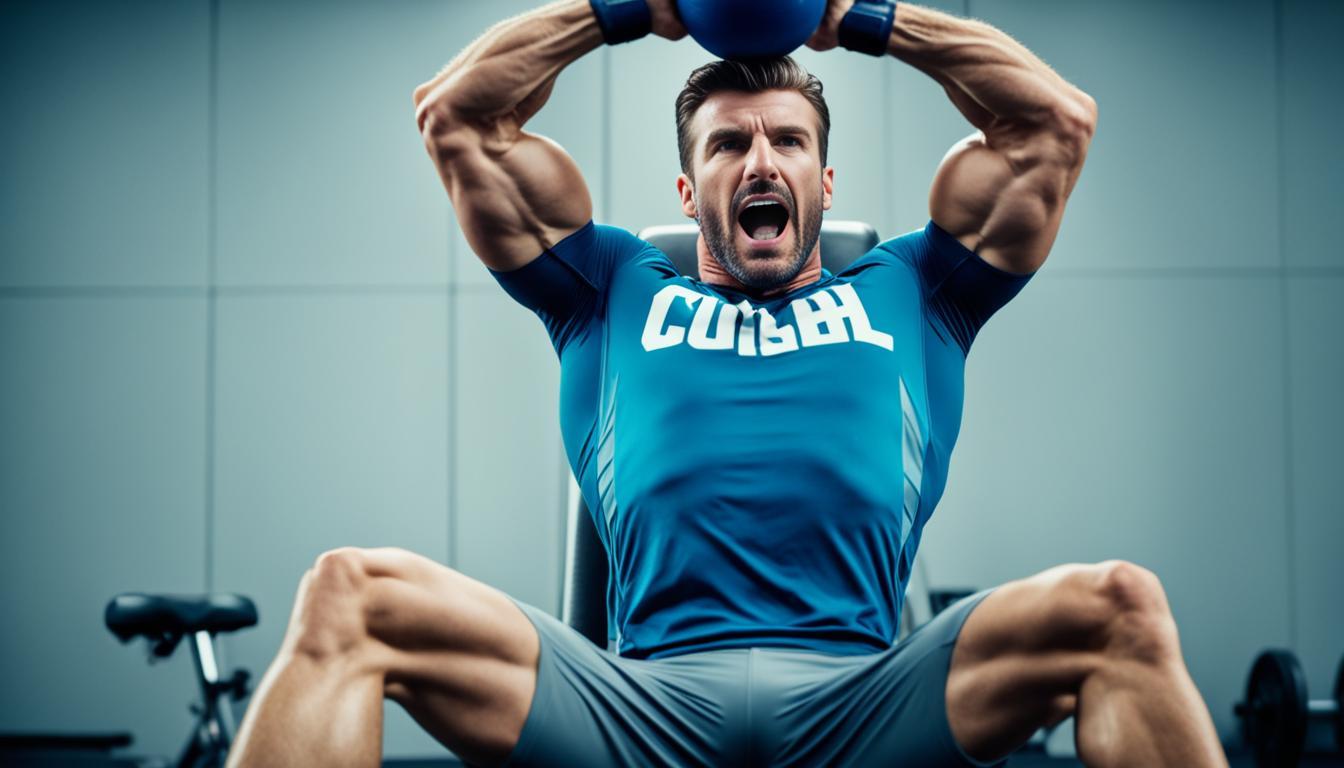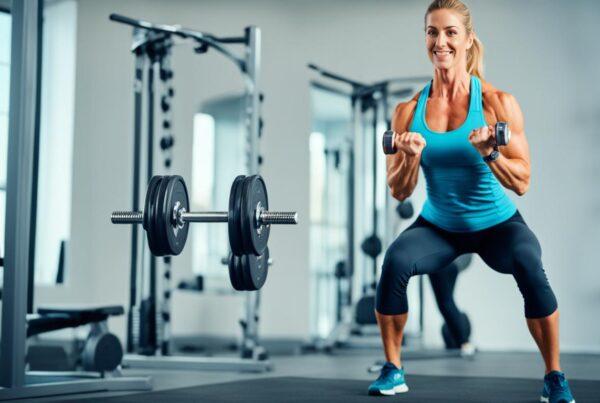Athletes in various sports understand the importance of a strong core for optimal performance. While traditional ab exercises have their benefits, they may not fully develop the core strength needed for athletes. That’s where specific ab exercises for athletes come into play.
Brandon Robb, a renowned coach, emphasizes the significance of understanding the different planes of motion and movement categories when training the core. By incorporating targeted exercises, athletes can strengthen their core muscles and enhance stability, rotational power, and overall athleticism.
Key Takeaways:
- Traditional ab exercises may not be sufficient for athletes.
- Developing core strength is essential for improved athletic performance.
- Understanding the different planes of motion is crucial for comprehensive core training.
- Targeted ab exercises can enhance stability and rotational power.
- Brandon Robb recommends five key ab exercises for athletes.
Ab Exercises for Athletes
The core is composed of several key muscles that play a vital role in trunk strength and stability. These muscles include:
- Rectus Abdominis: Located in the front of the abdomen, this muscle group is responsible for trunk flexion.
- Transverse Abdominis: Found deep within the abdominal wall, the transverse abdominis provides core stabilization.
- Internal and External Obliques: The oblique muscles allow for trunk rotation and lateral flexion.
- Quadratus Lumborum: Located on either side of the lumbar spine, the quadratus lumborum helps with lateral flexion and stabilization.
- Thoracolumbar Fascia: This connective tissue provides support and stability to the spine and core.
- Erector Spinae: Found in the lower back, the erector spinae muscles assist with spinal extension.
- Hip Muscles: The hip muscles, including the glutes and hip flexors, contribute to core stability and movement.
Having a clear understanding of these core muscles is crucial for designing an effective training program that targets all aspects of core strength.
Movement occurs in three primary planes: sagittal, frontal, and transverse.
The sagittal plane: divides the body into left and right sections and involves forward and backward movements.
The frontal plane: separates the body into front and back portions and involves lateral movements.
The transverse plane: divides the body into upper and lower sections and involves rotational movements.
While many traditional abdominal exercises focus primarily on trunk flexion in the sagittal plane, it’s important to train the core in all planes of motion to enhance athletic performance and reduce the risk of injuries.
By incorporating exercises that target each plane of motion, athletes can develop a well-rounded core and improve overall athleticism. The next sections will delve into specific exercise categories that address flexion and extension, lateral flexion and extension, rotation, anti-rotation, and bracing—critical components of a comprehensive core training program.
Category 1: Flexion & Extension Exercises
Flexion and extension exercises are essential for targeting the front and back muscles of your core. These exercises help improve strength, stability, and overall performance. One classic example of a flexion and extension exercise is the superman. To perform this exercise:
- Lie face down on the floor or mat.
- Extend your arms forward and keep your legs straight.
- Simultaneously lift your arms, legs, chest, and upper thighs off the ground.
- Hold the lifted position for a few seconds, focusing on engaging your core muscles.
- Slowly lower back down to the starting position.
The superman exercise primarily targets the gluteus maximus, thoracolumbar fascia, and erector spinae muscles. These muscles play a crucial role in supporting your spine and improving your posture. By incorporating variations of the superman exercise, such as GHD hip extensions and single-leg supermans, you can add variety and challenge to your core workout routine.
Benefits of Flexion & Extension Exercises:
Flexion and extension exercises offer several benefits for athletes:
“Flexion and extension exercises help strengthen the muscles responsible for spinal stabilization and improved athletic performance.” – Brandon Robb, Coach
| Benefits of Flexion & Extension Exercises | How They Help |
|---|---|
| Enhanced core strength | By targeting the front and back muscles of the core, flexion and extension exercises promote overall core strength and stability. |
| Improved posture | Flexion and extension exercises help strengthen the muscles that support the spine, leading to better posture and alignment. |
| Injury prevention | A strong core built through flexion and extension exercises helps protect the spine and prevent common injuries during sports and physical activities. |
| Increased power and performance | By targeting the gluteus maximus and erector spinae muscles, flexion and extension exercises enhance power and performance in various athletic movements requiring core strength. |
Category 2: Lateral Flexion & Extension Exercises
Lateral flexion and extension exercises are essential for targeting the side-to-side movements of your core. By incorporating these exercises into your training routine, you can build stability and power in lateral movements, improve your overall athleticism, and enhance your sports performance.
One effective lateral flexion and extension exercise is the KB/DB teapot exercise. This exercise involves bending sideways while holding a kettlebell or dumbbell, engaging the obliques and quadratus lumborum. The teapot exercise helps strengthen these muscles, which play a crucial role in stabilizing and supporting your core during lateral movements.
Here’s how to perform the KB/DB teapot exercise:
- Stand with your feet hip-width apart, holding a kettlebell or dumbbell in your right hand.
- Keep your core engaged and your back straight.
- Bend sideways towards your left side, keeping your arm extended and the weight close to your body.
- Return to the starting position and repeat on the other side.
Variations of the teapot exercise, such as single-leg or staggered stance teapots, can provide additional challenges and further improve your lateral strength and stability.
Remember to start with light weights and gradually increase the resistance as you become more comfortable with the exercise. As with any exercise, it’s important to maintain proper form and listen to your body to avoid injury.
Now let’s take a look at a table that summarizes the benefits and variations of lateral flexion and extension exercises:
| Lateral Flexion & Extension Exercises | Benefits | Variations |
|---|---|---|
| KB/DB Teapot Exercise | Builds stability and power in lateral movements | Single-leg teapots, staggered stance teapots |
| Side Plank | Strengthens obliques, improves lateral stability | Side plank with leg lift, side plank rotations |
| Standing Side Bends | Targets obliques, enhances lateral flexibility | Weighted side bends, cable side bends |

By incorporating these lateral flexion and extension exercises into your core training routine, you can develop a well-rounded and powerful core that will support you in various sports and everyday activities. Remember to consult with a fitness professional or coach to ensure proper form and execution of these exercises for optimal results.
Category 3: Rotation Exercises
When it comes to core training, rotation exercises often get overlooked. However, incorporating rotational movements into your workout routine is crucial for developing a strong and stable core. One highly effective exercise for rotational stability is the ISO lunge banded rotation.
The ISO lunge banded rotation exercise involves assuming a staggered stance and using a resistance band to create tension. From this position, you rotate your torso while maintaining a stable lower body. This exercise mimics the movements seen in sports like football and frisbee catching, where rotational stability is essential for optimal performance.
By including rotation exercises in your core training, such as the ISO lunge banded rotation, you can enhance your performance in activities that require core rotation, like golf swings. These exercises help improve your rotational power, allowing you to generate more force and control in your movements.
Here are some variations of rotation exercises that you can incorporate into your workout routine:
- Russian twists: Sit on the ground with your knees bent and feet off the floor. Holding a weight or medicine ball, rotate your torso from side to side while keeping your core engaged.
- Rotational medicine ball throws: Stand with your feet shoulder-width apart, holding a medicine ball. Rotate your torso, swinging the ball from one side to the other, as if passing it to someone.
These variations provide additional challenge and variety to your rotation exercises, targeting different muscles in your core and enhancing overall rotational stability and power.
“Rotation exercises are often neglected in core training programs. By incorporating rotational movements like the ISO lunge banded rotation, you can enhance your core stability and improve your performance in sports and other activities that require rotational power.”
Category 4: Anti-Rotation Exercises
Anti-rotation exercises play a vital role in developing stability and resistance against external forces. By incorporating these exercises into your core training routine, you can enhance your overall athletic performance and minimize the risk of injuries. One effective anti-rotation exercise is the Pallof press.
The Pallof press targets key muscles including the transverse abdominis, internal and external obliques, and hip muscles. To perform this exercise, you will need a band or cable machine. Start by standing perpendicular to the band or cable machine, positioning the handle at chest height. Stand with your feet shoulder-width apart and your core engaged.
Grasp the handle with both hands and extend your arms in front of your chest, keeping your elbows slightly bent. Maintain a stable and upright position. You will feel a rotational force trying to pull you towards the machine, so resist the rotation by engaging your core and maintaining a neutral spine. Hold this position for a few seconds before retracting your arms back to your chest.
To add variety and intensify the exercise, you can incorporate variations such as Pallof press squats and landmine anti-rotations into your routine. These variations challenge the core from different angles and positions, further improving stability and resilience against rotational forces.
Benefits of Anti-Rotation Exercises:
- Enhance core stability
- Improve resistance to external forces
- Reduce the risk of injuries
- Enhance overall athletic performance
Incorporating anti-rotation exercises like the Pallof press into your core workout routine will equip you with the strength and stability needed for the demands of your sport. Remember to start with proper form and gradually increase the resistance as your core muscles become stronger. By consistently including anti-rotation exercises in your training, you’ll be well on your way to achieving a powerful and resilient core.
Category 5: Bracing Exercises
Bracing exercises play a crucial role in developing core stability while performing limb movements. One popular exercise that athletes swear by is the deadbug exercise. To perform this exercise, lie on your back with your arms and legs extended. Then, move your opposite limbs while keeping your core engaged. Not only does this exercise target the deep abdominal muscles, but it also promotes stability during dynamic movements.
In addition to the deadbug, incorporating other bracing exercises like bridges and half-airplanes can further enhance your core strength and stability. Bridges are particularly effective for activating the glutes, while half-airplanes engage your entire core by balancing on one leg and reaching towards the opposite foot. These exercises challenge your core’s ability to maintain stability, ultimately improving overall athletic performance.
By including bracing exercises in your core training routine, you can develop the necessary stability to excel in your sport. Remember, a strong and stable core is the foundation for explosive movements, injury prevention, and improved athletic performance. So, don’t neglect the importance of incorporating bracing exercises into your training regimen. Your body will thank you for it!








